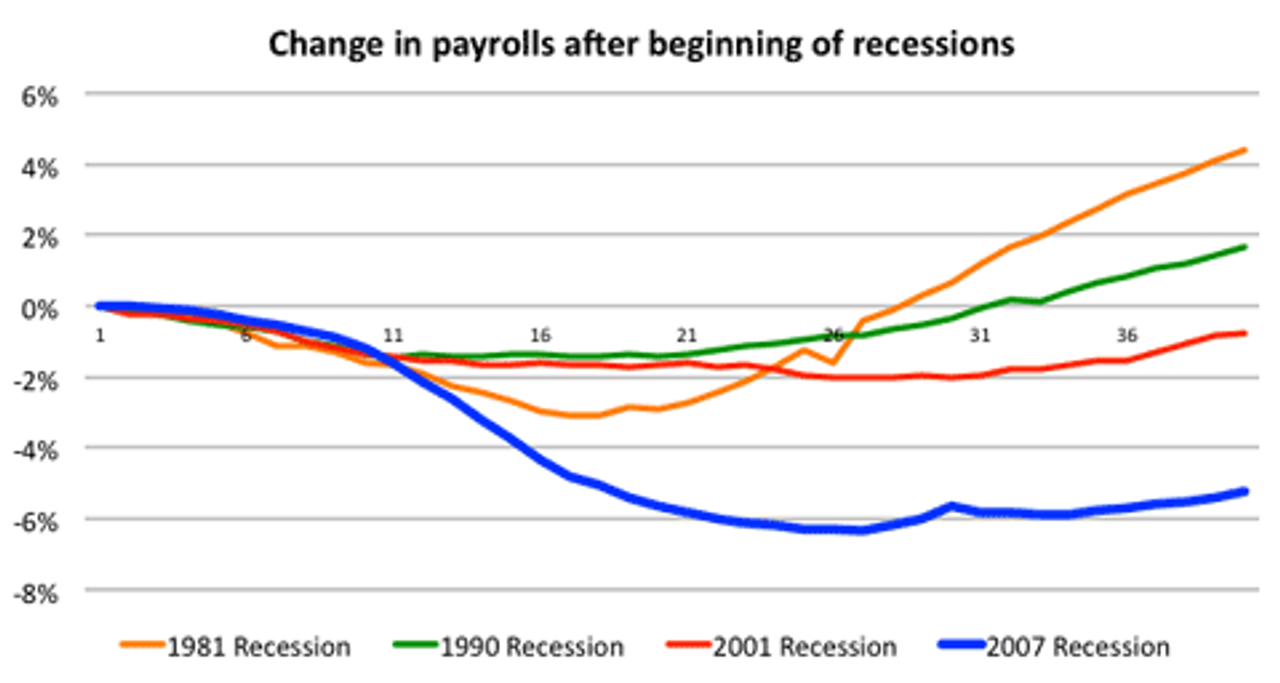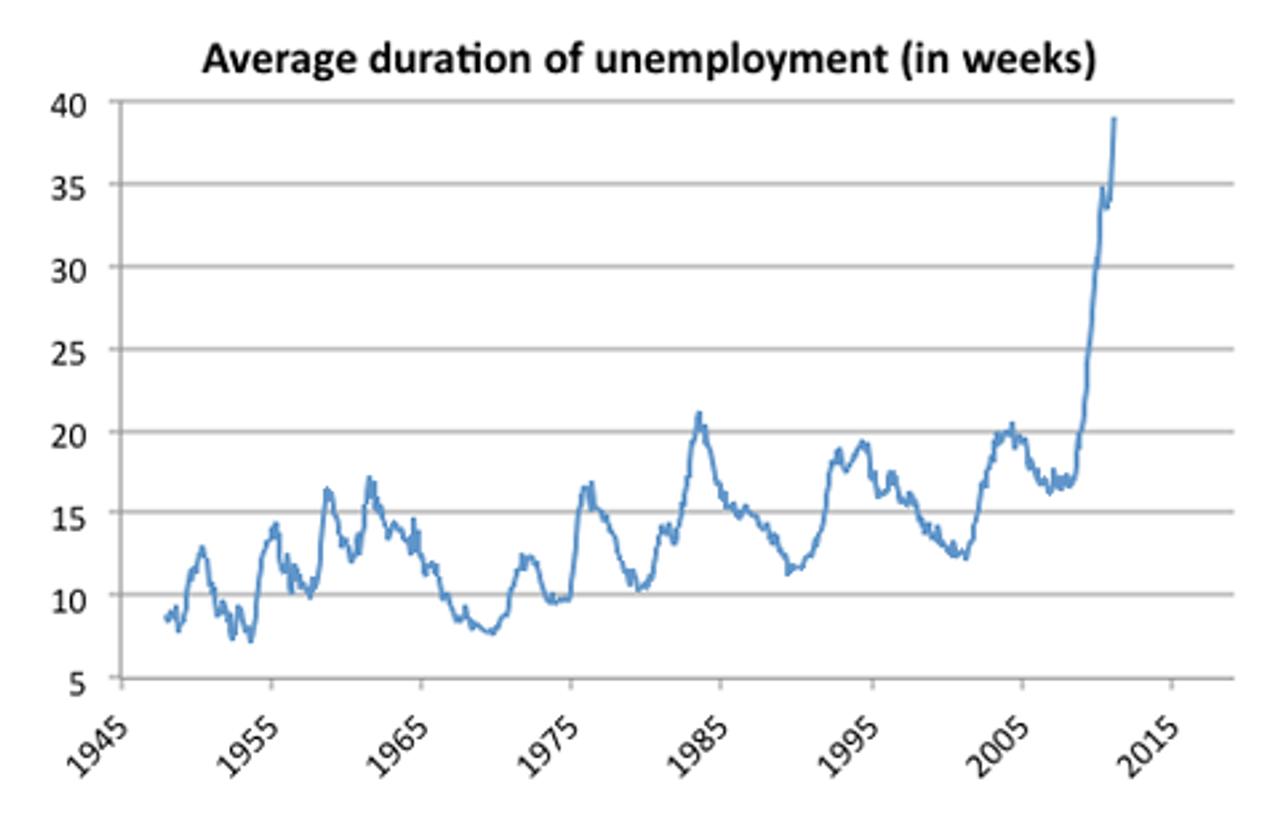The Labor Department reported Friday that the US economy added 216,000 jobs in March, putting a small dent in the 7.2 million jobs that have been lost since the start of the recession in December of 2007.
 Economists estimate that to return to the pre-recession jobless rate in three years, about twice as many jobs would have to be added every month. Other data in the Labor Department’s monthly employment report underscore the deepening social crisis resulting from long-term unemployment on a mass scale.
Economists estimate that to return to the pre-recession jobless rate in three years, about twice as many jobs would have to be added every month. Other data in the Labor Department’s monthly employment report underscore the deepening social crisis resulting from long-term unemployment on a mass scale.
* The labor force participation rate held steady at 64.2 percent, the lowest level since 1984. The labor force (the number of people aged 16 or over working or actively looking for work) is smaller than it was a year ago (by more than a half-million workers), though the working-age population grew by 1.9 million.
* The share of the population with a job was 58.5 percent in March. Prior to the current slump, the last time it was lower was in 1983.
* The section of unemployed workers who have been without a job for more than six months increased in March, from 43.9 percent to 45.5 percent, approaching the all-time high of 45.6 percent last May. There remain 6.1 million workers who have been unemployed for longer than six months.
* The average duration of unemployment grew to 39 weeks in March, up from 37.1 weeks in February of this year and 31.7 in March of last year. The current average duration of unemployment is three times the historical average for the entire postwar period before 2007, and nearly twice the highest level of 21.2 weeks the figure had previously reached in records going back over sixty years.
* The underemployment rate, which includes those who have given up looking for work and part-time workers who want a full-time job, was 15.7 percent. In March, a total of 24.5 million workers were either unemployed or underemployed, nearly double the level of 12.9 million in 2007.
Despite such grim facts, the Obama administration seized on Friday’s report, including a decline in the official jobless rate from 8.9 percent to 8.8 percent, to proclaim a turnaround in the jobs market. Speaking at a UPS shipping facility in Washington DC, Obama said, "Our economy is showing signs of real strength."
 Labor Secretary Hilda L. Solis declared, “The bottom line: the policies and programs of this administration are working.”
Labor Secretary Hilda L. Solis declared, “The bottom line: the policies and programs of this administration are working.”
From the standpoint of big business, which is reporting record profits based largely on downsizing and wage cutting, Solis is correct. From the standpoint of the working class, she and the rest of the administration, as well as most of the media, are lying.
The Obama administration and the ruling class as a whole are seeking to spin the recent jobs figures to create the image of a strongly rebounding economy and an end to the jobs crisis. Under the cover of this phony recovery, both political parties will mount an escalating attack on the already inadequate benefits provided to jobless workers.
This new phase in the ruling class offensive against the working class has already begun, with Michigan slashing the duration of jobless benefits from 26 to 20 weeks, and Florida primed to enact its own cuts in unemployment benefits. In Missouri, state legislators this week blocked federal unemployment benefits for residents, meaning that 10,000 people will be cut off of assistance starting next week.
At the same time, the assault on public-sector jobs will continue. During Obama's tenure, 416,000 such jobs have been destroyed, with about 300,000 of those coming in the past year.
While the US economy has created jobs for six consecutive months, the rate of job creation is far lower than in the aftermath of previous recessions. (According to the government, the US recession officially ended in June of 2009). All of the jobs wiped out in the 1981 recession were replaced within 28 months of its end. Following the 1990 recession, it took 31 months. Forty weeks after the start of the 1981 recession, the US economy had created 4 million more jobs than existed at the start of the downturn.
In its analysis of the March jobs report, the Economic Policy Institute, a Washington-based think tank, put the raw payroll numbers in perspective. It wrote:
“If the labor force participation rate had held steady over the last year, there would be roughly 1.7 million more workers in the labor force right now. Instead, those would-be workers are on the sidelines. If these workers were in the labor force and were unemployed, the unemployment rate would be 9.8 percent instead of 8.8 percent. In other words, the improvement in the unemployment rate over the last year (from 9.7 percent to 8.8 percent) is due to would-be workers deciding to sit out.”
Most of the new jobs that are being created are in low-wage service industry sectors. The share of the work force earning poverty level or near-poverty wages is increasing. A study published Friday by Wider Opportunities for Women reported: "Fewer than 13 percent of jobs... to be created by 2018 are likely to provide economic security to a single parent raising two or more children. A small majority of new jobs are expected to pay economic security wages for single workers without children, and approximately 43 percent of the new jobs will pay economic security wages for two workers raising two young children."
One of the most telling indicators of the real state of the economy is the ongoing decline in house sales and prices, which is closely linked to mass unemployment. Following disastrous reports last week showing record falls in the sale of existing and new homes, the S&P/Case Shiller home price index for January was released earlier this week. It showed that home prices fell a further 3.1 percent from January of 2010.
